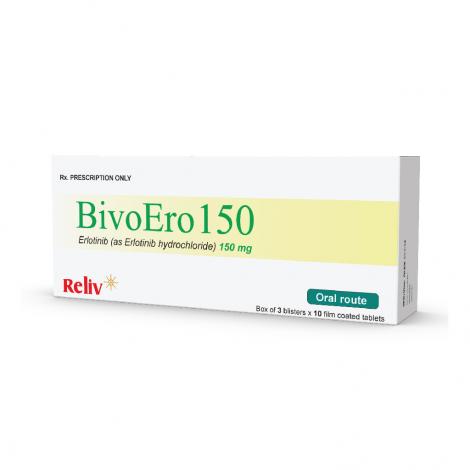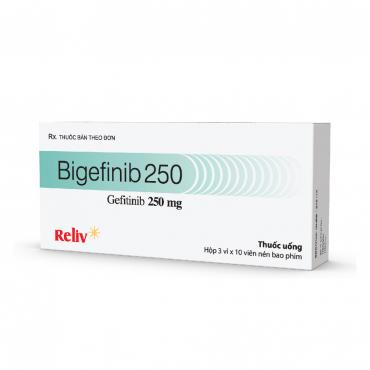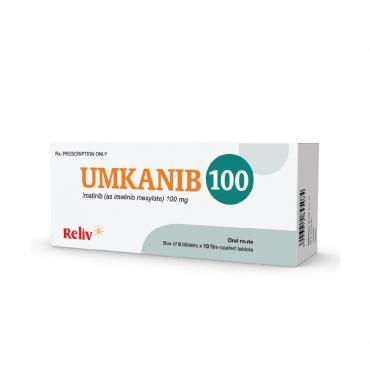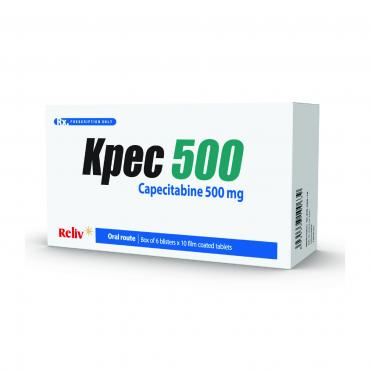Erlotinib treatment should be supervised by a physician experienced in the use of anti-cancer therapies.
Patients with Non-Small Cell Lung Cancer
EGFR mutation testing should be performed in accordance with the approved indications.
The recommended daily dose of Erlotinib is 150 mg taken at least one hour before or two hours after the ingestion of food.
Patients with pancreatic cancer
The recommended daily dose of Erlotinib is 100 mg taken at least one hour before or two hours after the ingestion of food, in combination with gemcitabine. In patients who do not develop rash within the first 4 – 8 weeks of treatment, further Erlotinib treatment should be re-assessed.
When dose adjustment is necessary, the dose should be reduced in 50 mg steps. Erlotinib is available in strengths of 25 mg, 100 mg and 150 mg.
Concomitant use of CYP3A4 substrates and modulators may require dose adjustment.
Hepatic impairment
Erlotinib is eliminated by hepatic metabolism and biliary excretion. Although erlotinib exposure was similar in patients with moderately impaired hepatic function (Child- Pugh score 7-9) compared with patients with adequate hepatic function, caution should be used when administering Erlotinib to patients with hepatic impairment. Dose reduction or interruption of Erlotinib should be considered if severe adverse reactions occur. The safety and efficacy of erlotinib has not been studied in patients with severe hepatic dysfunction (AST/SGOT and ALT/SGPT> 5 x ULN). Use of Erlotinib in patients with severe hepatic dysfunction is not recommended.
Renal impairment
The safety and efficacy of erlotinib has not been studied in patients with renal impairment (serum creatinine concentration >1.5 times the upper normal limit). Based on pharmacokinetic data no dose adjustments appear necessary in patients with mild or moderate renal impairment. Use of Erlotinib in patients with severe renal impairment is not recommended.
Paediatric population
The safety and efficacy of erlotinib in the approved indications has not been established in patients under the age of 18 years. Use of Erlotinib in paediatric patients is not recommended.
Smokers
Cigarette smoking has been shown to reduce erlotinib exposure by 50-60%. The maximum tolerated dose of Erlotinib in NSCLC patients who currently smoke cigarettes was 300 mg. The 300 mg dose did not show improved efficacy in second line treatment after failure of chemotherapy compared to the recommended 150 mg dose in patients who continue to smoke cigarettes. Safety data were comparable between the 300 mg and 150 mg doses; however there was a numerical increase in the incidence of rash, interstitial lung disease and diarrhoea, in patients receiving the higher dose of erlotinib. Current smokers should be advised to stop smoking.
METHOD OF ADMINISTRATION: Oral administration, Erlotinib should be taken at least one hour before or two hours after a meal.
Hypersensitivity to erlotinib or to any of the excipients of this drug.
Assessment of EGFR mutation status
When considering the use of Erlotinib as a first line or maintenance treatment for locally advanced or metastatic NSCLC, it is important that the EGFR mutation status of a patient is determined. A validated, robust, reliable and sensitive test with a prespecified positivity threshold and demonstrated utility for the determination of EGFR mutation status, using either tumor DNA derived from a tissue sample or circulating free DNA (cfDNA) obtained from a blood (plasma) sample, should be performed according to local medical practice. If a plasma-based cfDNA test is used and the result is negative for activating mutations, perform a tissue test wherever possible due to the potential for false negative results from a plasma-based test.
Smokers
Current smokers should be advised to stop smoking, as plasma concentrations of erlotinib in smokers as compared to non-smokers are reduced. The degree of reduction is likely to be clinically significant.
Interstitial Lung Disease
Cases of interstitial lung disease (ILD)-like events, including fatalities, have been reported uncommonly in patients receiving erlotinib for treatment of non-small cell lung cancer (NSCLC), pancreatic cancer or other advanced solid tumours. In the pivotal study BR.21 in NSCLC, the incidence of ILD (0.8%) was the same in both the placebo and erlotinib groups. In a meta-analysis of NSCLC randomised controlled clinical trials (excluding phase I and single-arm phase II studies due to lack of control groups), the incidence of ILD-like events was 0.9% on erlotinib compared to 0.4% in patients in the control arms. In the pancreatic cancer study in combination with gemcitabine, the incidence of ILD-like events was 2.5% in the erlotinib plus gemcitabine group versus 0.4% in the placebo plus gemcitabine treated group. Reported diagnoses in patients suspected of having ILD-like events included pneumonitis, radiation pneumonitis, hypersensitivity pneumonitis, interstitial pneumonia, interstitial lung disease, obliterative bronchiolitis, pulmonary fibrosis, Acute Respiratory Distress Syndrome (ARDS), alveolitis, and lung infiltration. Symptoms started from a few days to several months after initiating erlotinib therapy. Confounding or contributing factors such as concomitant or prior chemotherapy, prior radiotherapy, pre-existing parenchymal lung disease, metastatic lung disease, or pulmonary infections were frequent. A higher incidence of ILD (approximately 5% with a mortality rate of 1.5%) is seen among patients in studies conducted in Japan.
In patients who develop acute onset of new and/or progressive unexplained pulmonary symptoms such as dyspnoea, cough and fever, Erlotinib therapy should be interrupted pending diagnostic evaluation. Patients treated concurrently with erlotinib and gemcitabine should be monitored carefully for the possibility to develop ILD-like toxicity. If ILD is diagnosed, Erlotinib should be discontinued and appropriate treatment initiated as necessary.
Diarrhoea, dehydration, electrolyte imbalance and renal failure
Diarrhoea (including very rare cases with a fatal outcome) has occurred in approximately 50% of patients on erlotinib and moderate or severe diarrhoea should be treated with e.g. loperamide. In some cases dose reduction may be necessary. In the clinical studies doses were reduced by 50 mg steps. Dose reductions by 25 mg steps have not been investigated. In the event of severe or persistent diarrhoea, nausea, anorexia, or vomiting associated with dehydration, Erlotinib therapy should be interrupted, and appropriate measures should be taken to treat the dehydration. There have been rare reports of hypokalaemia and renal failure (including fatalities). Some cases were secondary to severe dehydration due to diarrhoea, vomiting and/or anorexia, while others were confounded by concomitant chemotherapy. In more severe or persistent cases of diarrhoea, or cases leading to dehydration, particularly in groups of patients with aggravating risk factors (especially concomitant chemotherapy and other medications, symptoms or diseases or other predisposing conditions including advanced age), Erlotinib therapy should be interrupted, and appropriate measures should be taken to intensively rehydrate the patients intravenously. In addition, renal function and serum electrolytes including potassium should be monitored in patients at risk of dehydration.
Hepatotoxicity
Serious cases of drug induced liver injury (DILI) including hepatitis, acute hepatitis and hepatic failure (including fatalities) have been reported during use of erlotinib. Risk factors may include pre-existing liver disease or concomitant hepatotoxic medications. Periodic liver function testing is recommended during treatment with erlotinib. The frequency of monitoring of liver function should be increased in patients with pre-existing hepatic impairment or biliary obstruction. Prompt clinical evaluation and measurement of liver function tests should be performed in patients who report symptoms that may indicate liver injury. Erlotinib dosing should be interrupted if changes in liver function are severe. Erlotinib is not recommended for use in patients with severe hepatic dysfunction.
Gastrointestinal perforation
Patients receiving Erlotinib are at increased risk of developing gastrointestinal perforation, which was observed uncommonly (including some cases with a fatal outcome). Patients receiving concomitant anti-angiogenic agents, corticosteroids, NSAIDs, and/or taxane based chemotherapy, or who have prior history of peptic ulceration or diverticular disease are at increased risk. Erlotinib should be permanently discontinued in patients who develop gastrointestinal perforation.
Bullous and exfoliative skin disorders
Bullous, blistering and exfoliative skin conditions have been reported, including very rare cases suggestive of Stevens-Johnson syndrome/Toxic epidermal necrolysis, which in some cases were fatal. Erlotinib treatment should be interrupted or discontinued if the patient develops severe bullous, blistering or exfoliating conditions. Patients with bullous and exfoliative skin disorders should be tested for skin infection and treated according to local management guidelines.
Ocular disorders
Patients presenting with signs and symptoms suggestive of keratitis such as acute or worsening: eye inflammation, lacrimation, light sensitivity, blurred vision, eye pain and/or red eye should be referred promptly to an ophthalmology specialist. If a diagnosis of ulcerative keratitis is confirmed, treatment with Erlotinib should be interrupted or discontinued. If keratitis is diagnosed, the benefits and risks of continuing treatment should be carefully considered. Erlotinib should be used with caution in patients with a history of keratitis, ulcerative keratitis or severe dry eye. Contact lens use is also a risk factor for keratitis and ulceration. Very rare cases of corneal perforation or ulceration have been reported during use of erlotinib.
Interactions with other medicinal products
Potent inducers of CYP3A4 may reduce the efficacy of erlotinib whereas potent inhibitors of CYP3A4 may lead to increased toxicity. Concomitant treatment with these types of agents should be avoided.
Other forms of interactions
Erlotinib is characterised by a decrease in solubility at pH above 5. Medicinal products that alter the pH of the upper Gastro-Intestinal (GI) tract, like proton pump inhibitors, H2 antagonists and antacids, may alter the solubility of erlotinib and hence its bioavailability. Increasing the dose of Erlotinib when co-administered with such agents is not likely to compensate for the loss of exposure. Combination of erlotinib with proton pump inhibitors should be avoided. The effects of concomitant administration of erlotinib with H2 antagonists and antacids are unknown; however, reduced bioavailability is likely. Therefore, concomitant administration of these combinations should be avoided. If the use of antacids is considered necessary during treatment with Erlotinib, they should be taken at least 4 hours before or 2 hours after the daily dose of Erlotinib.








